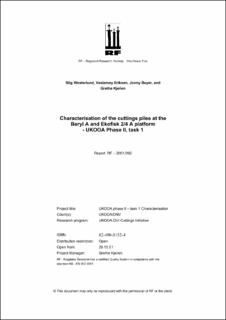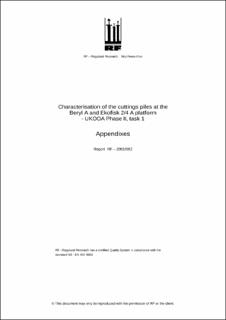| dc.description.abstract | The cuttings piles at Beryl A and Ekofisk 2/4 A have been characterised according to the recommendations in the OLF Guidelines. The characterisation parameters selected from these Guidelines
were the most feasible ones based on RF’s experience from sampling and characterisation of other cuttings piles in the North Sea. Analysis parameters not within the OLF guidelines have also been included.
PART 1: Contour mapping from recent surveys was used to plan the sampling program during the fieldwork. The selected physical parameters included: cone penetration, shear strength, grain size distribution and density. The selected chemical parameters were the organic contaminants: THC, PAH, NPDs, Decalines, and the metals: Al, V, Mn, Fe, Ba, Cr, Co, Ni, Cu, Zn, As, Sr, Cd, Pb and Hg as well as the chemical components: TOC, TON, pH, Redox potential (eH) and sulphide. These parameters were analysed on samples/cores taken at both cuttings piles. Other parameters not included within the OLF guidelines were; PCB (“Dutch 7”), mineralogy, radioactivity (NORM, carried out by TNO/D&M as part of task 2c) and screening of hormonal effects (endocrine disruption). Further work on metals speciation using a sequential extraction procedure to access the availability of metals has also been carried out. At the Ekofisk 2/4A, cuttings pile contaminants data were available from a previous investigation in 1998. These data were also assessed in the characterisation work. Sampling for benthos was also performed, and specimen taxa and diversity indexes calculated. The experience obtained from fieldwork on appropriate cuttings pile sampling methods have been included in the report and assessed.
In addition to collecting samples for the characterisation purpose, bulk material to be used in a series of other experiments within the UKOOA phase II were collected.
PART 2: Bioavailability of metals was investigated by sequential extraction and subsequent analyses.
PART 3: The potential for drill cuttings to cause endocrine effects was investigated together with potential impacts of PCBs. | en_US |

